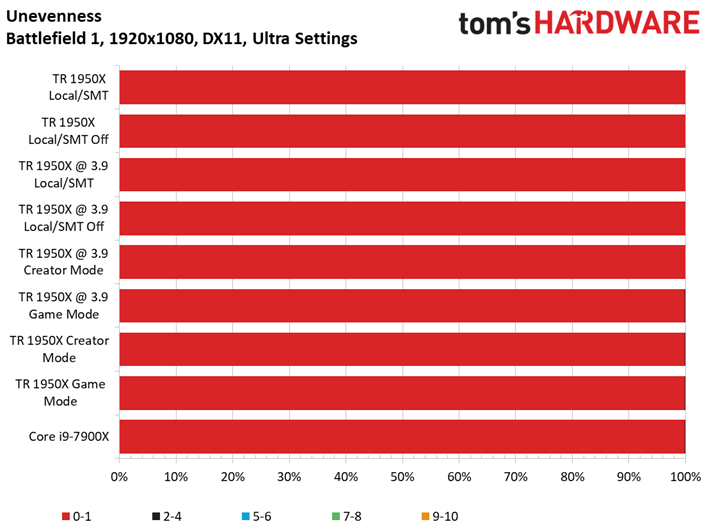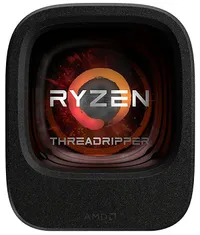AMD Ryzen Threadripper 1950X Game Mode, Benchmarked
Battlefield 1, Dawn of War III & Grand Theft Auto V
Battlefield 1 (DX11)






Battlefield 1 benefits from disabling SMT, which enables the best overall performance in both stock and overclocked configurations. The title does not respond well to AMD's Game mode, which shows up in the chart's lowest position. Tuning only helps a little bit. Creator mode performs surprisingly well in both stock and overclocked configurations.
Warhammer 40,000: Dawn of War III






Game mode yields the best performance at stock and overclocked settings.
The Local/SMT options (on and off) both offer similar performance, with Local/SMT taking a slight lead. Notably, Creator mode suffers from reduced performance in both configurations; even tuning can't give it an edge over Game mode at stock clock rates.
Grand Theft Auto V






Grand Theft Auto V responds well to Game mode in both stock and overclocked configurations, while the Local/SMT configurations offer similar average frame rates. Creator mode trails the other configurations again, but the performance delta isn't as pronounced as we've seen in other titles.
MORE: Best CPUs
MORE: Intel & AMD Processor Hierarchy
MORE: All CPUs Content
Get Tom's Hardware's best news and in-depth reviews, straight to your inbox.
Current page: Battlefield 1, Dawn of War III & Grand Theft Auto V
Prev Page AotS: Escalation & Civilization VI Next Page Hitman, Shadow of Mordor & Project CARS
Paul Alcorn is the Editor-in-Chief for Tom's Hardware US. He also writes news and reviews on CPUs, storage, and enterprise hardware.
-
beshonk "extra cores could enable more performance in the future as software evolves to utilize them better"Reply
I can't believe we're still saying this in 2017. Developers suck at their job. -
sztepa82 "AMD aims Threadripper at content creators, heavy multitaskers, and gamers who stream simultaneously. It also says the processors are ideal for gaming at high resolutions. Ryzen Threadripper 1950X isn't intended for playing around at low resolutions, particularly in older, lightly-threaded titles. ____Still, we tested at 1920x1080____ ...."Reply
Thank you for being out there for us, Tom's, no other website has ever done that. The only other thing we can hope for is that you'll also do a 2S Epyc 7601 review playing Project Cars in 320x240. -
shrapnel_indie ReplyEach change requires a reboot, chewing up precious time as you save open projects, halt conversations, and try to remember which web browser tabs to relaunch.
not if you're running the right browser with the right options active. Firefox can remember the last tabs you had open and reopen them upon startup... of course this is within the last Firefox window closed, and you have to properly exit. (no killing the thread(s).) -
-Fran- Since this CPU (and Intel's X and XE line) are aimed for big spenders, when are you guys going to test multi GPU in these CPUs?Reply
Also, you mentioned streaming as part of the big CPU charisma, but there was no actual test with it. Why not just run OBS with the same software encoding settings for each platform and run a game? It's not that hard to do, is it?
Cheers! -
Dyseman Quote- 'When I go to pause the video (ad) your site takes me to another tab. Bye, bye.'Reply
It's easy enough to disable the JW Player with ublock. Those videos are not considered ads but adblockers, but you can tell it to block anything that uses JW Player, then whitelist any other site that needs to use it for NON-ADs. -
rhysiam Thanks for this investigation Toms, really thorough and interesting article.Reply
It's interesting and a little disappointing that an OC to 3.9Ghz seems to pretty consistently achieve a small but measurable bump in gaming. The 1950X can use XFR to get to 4.2Ghz on lightly threaded workloads. Obviously in well-threaded games the CPU isn't going to be able to sustain 4.2Ghz, but it's a bit disappointing it can't manage 3.9-4ghz across the 4-6 cores used in gaming workloads. In fact, judging from the results it seems to be sitting around 3.7-3.8Ghz or so in most games. That seems low to me. There should be plenty of thermal and power headroom available to to get 4-6 cores up to nice high clocks, which should be enough cores for pretty much every game in the suite (except perhaps AOTS). If that was happening we'd see the OC making no difference, or even perhaps causing a slight performance regression in games (like it does in synthetic single-threaded tests). But clearly that's not the case.
It seems to me that AMD's power management implementation is resulting in some pretty conservative clock speeds in the 4-6 core workload range. That has implications outside of gaming as well, because 4-6 thread workloads are quite common even in the productivity and content creation space. It's hardly a deal breaker (we're only looking a couple of hundred mhz), but I'm curious whether others think AMD is giving up a little more performance than they should be here? Or am I missing something? -
jdwii Reply20187640 said:Thanks for this investigation Toms, really thorough and interesting article.
It's interesting and a little disappointing that an OC to 3.9Ghz seems to pretty consistently achieve a small but measurable bump in gaming. The 1950X can use XFR to get to 4.2Ghz on lightly threaded workloads. Obviously in well-threaded games the CPU isn't going to be able to sustain 4.2Ghz, but it's a bit disappointing it can't manage 3.9-4ghz across the 4-6 cores used in gaming workloads. In fact, judging from the results it seems to be sitting around 3.7-3.8Ghz or so in most games. That seems low to me. There should be plenty of thermal and power headroom available to to get 4-6 cores up to nice high clocks, which should be enough cores for pretty much every game in the suite (except perhaps AOTS). If that was happening we'd see the OC making no difference, or even perhaps causing a slight performance regression in games (like it does in synthetic single-threaded tests). But clearly that's not the case.
It seems to me that AMD's power management implementation is resulting in some pretty conservative clock speeds in the 4-6 core workload range. That has implications outside of gaming as well, because 4-6 thread workloads are quite common even in the productivity and content creation space. It's hardly a deal breaker (we're only looking a couple of hundred mhz), but I'm curious whether others think AMD is giving up a little more performance than they should be here? Or am I missing something?
Ryzen hits a certain point in return pretty darn fast for example CPU might only use 1.15V to get 3.6ghz stable but 3.9ghz needs like 1.3V way to much. -
papality Reply20185985 said:"extra cores could enable more performance in the future as software evolves to utilize them better"
I can't believe we're still saying this in 2017. Developers suck at their job.
Intel's billions had a lot to say in this.
